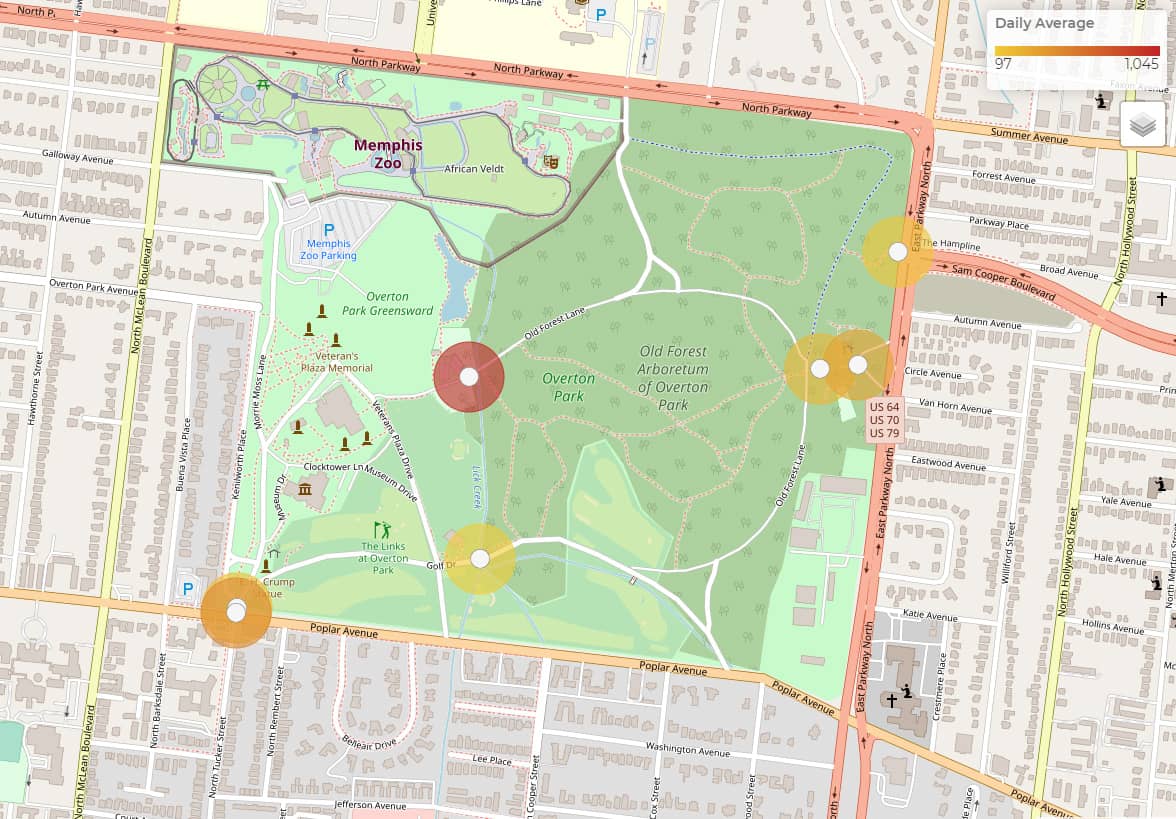Making it count in Overton Park

Watching the Poplar/Tucker entrance to Overton Park for eight years, our staff could confidently say that park usage peaks during the beautiful days of March. For the first time, we can quantify that observation with real data from the park.
With support from International Paper, the Plough Foundation, and Hyde Family Foundation, this winter the Conservancy installed seven mechanized visitor counters at various entrances to Overton Park. The two vehicle counters (at Poplar/Tucker and East Parkway) and five bike/pedestrian counters (at Poplar/Tucker, the Bike Gate arch, and the three Old Forest gateways) allow us to measure park usage over time.
It’s no surprise that warm, sunny days show the highest number of visitors. But we’ve gathered some other interesting information, particularly on how the evolving threat of COVID-19 impacted park use.
A Park and a Pandemic
Park use in 2020 peaked during Mayor Strickland’s shelter-in-place order at all but one location. With businesses across the city closed and Memphians searching for fresh air, visitors packed the park, forcing incremental shutdowns to dispel crowds. Here’s a timeline of what the numbers show us:
Thursday, March 19 – Overton Park Conservancy closes playgrounds, restrooms, and the dog park; Memphis Zoo closes to visitors.
Thursday, March 26 – Peak usage day at East Parkway entrance (nearly 700 cars vs. a 237 daily average). Over 400 of these visitors crossed into the Old Forest on foot or by bike through the “Growth” gateway.
Friday, March 27 – Mayor Strickland issues a message to park users: refrain from congregating in parks or they may have to be closed.
Sunday, March 29 – Peak usage day at “Old Growth” gateway between Overton Bark and Rainbow Lake Playground. More than 2,300 pedestrians and cyclists were recorded passing through the
gate on this day, nearly double the average weekend traffic for this gate.
Tuesday, March 31 – Mayor Strickland closes the park to vehicle traffic. Following the vehicle closure order, pedestrians and cyclists entering the Old Forest from the west dropped by 30% and visitors entering from the east dropped by 45%. This reduced usage allowed the park to remain open rather than closing entirely.
Missing Our Neighbors
The exception to peak usage in late March was the Poplar/Tucker vehicle counter, which saw its highest totals on the weekend of March 7. More than 2,500 cars entered the park here during that Saturday and Sunday, up from 2,100 the weekend before. These were both temperate, sunny weekends–the kind that we’ve always anecdotally called our peak days. Compare those numbers to the weekend of March 28-29, after the Memphis Zoo and Brooks Museum had closed their doors. In similar weather conditions, only about 750 cars entered at the Poplar/Tucker entrance. That’s still a high number under the circumstances of the pandemic, but it gives us a rare chance to see how much of the park traffic is going to cultural attractions vs. using the park recreationally.
While the spring of 2020 won’t provide us with a “normal-year” baseline, it’s been important for us to measure usage during a time when the park has provided some people with their only escape. Once life returns to normal, we plan to supplement the data with user surveys that tell us more about who’s visiting the park, where they’re coming from, and what areas they’re visiting. We’ll share the data with our park partners and colleagues at Shelby Farms Park Conservancy, Memphis River Parks Partnership, the Wolf River Conservancy, and the City of Memphis.



